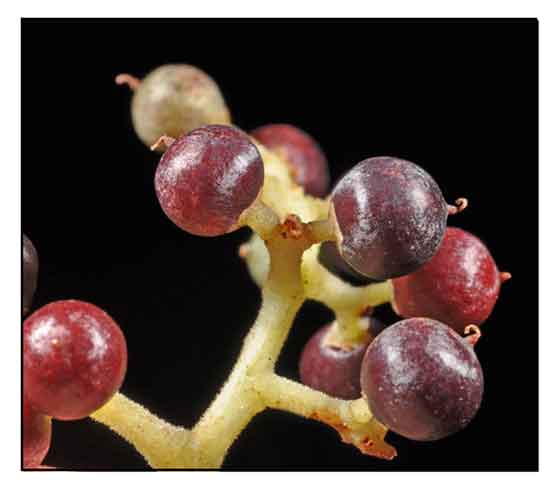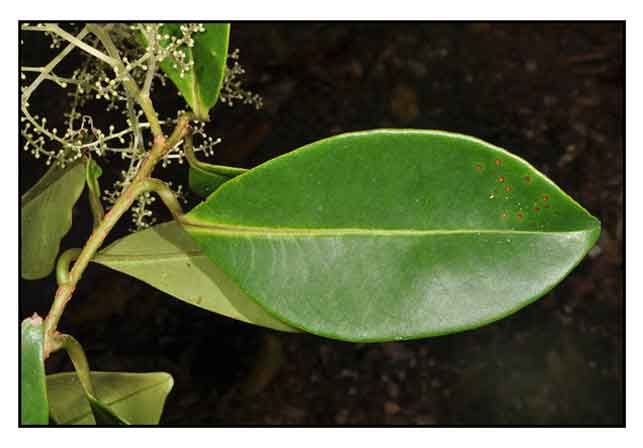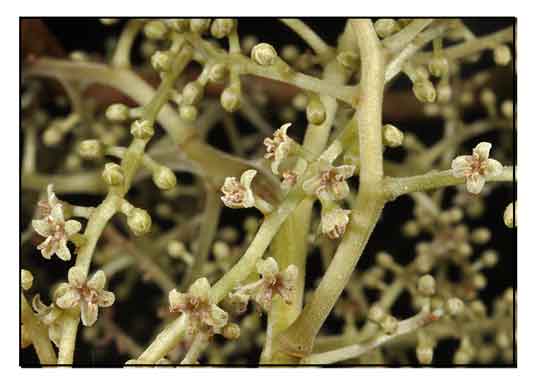 Botany Botany
Embelia philippinensis is a woody vine with smooth and glabrous branches and spiny stems when old, growing to a length of 4 meters and a diameter of 5 to 15 mm.
Leaves are alternate, elliptic, leathery and smooth, 7, 3.5 to 4.2 cm wide to 14 cm long, acuminate, with entire margins, acute base, prominent midrib, distinct lateral veins, the upper surface shiny and dark green, and light green undersurface. Fruit is a berry with an apiculate style, up to 0.5 cm in diameter, red when ripe, edible, with a sweet-sour taste. (6)
Distribution
- Endemic in the Philippines.
- Sparsely distributed in northern Luzon and southern Mindanao.
- In open or partially shaded secondary forests at low and medium altitudes.
 Constituents Constituents
- GC-MS study of aqueous and methanol extracts of roots yielded 9,12-octadecadienoic acid, methyl ester; eicosane; hexadecane; hexadecanoic acid, methyl ester; 9,12-octadecatrienoic acid, (ZZ); 9,12,15-octadecatrienoic acid (ZZZ); n-hexadecanoic acid; squalene; phenol; 2,4-bis (1,1-dimethyl); and 1,2-benzenedicarboxylic acid, bis (20methylropyl) ester. (see study below) (3)
Properties
Studies have suggested antioxidant, antibacterial, anticoagulant properties.
Parts used
Whole plant, roots, leaves.
Uses
Edibility
- Fruits are edible, sweet-sour in taste. The fleshy pericarp of the ripe fruit is eaten raw. (5)
- Leaves used as food by the Ayta people in Porac, Pampanga province. (5)
- Leaves cooked with fish, meat, pr vegetables to give a sour-flavoured taste. (6)
Folkloric
- In the Philippines, the Talaandig tribe of Bukidnon use the plant for the treatment of tumors, cysts, and some cancers. (3)
Others
- Tying: Mature fresh stems are used as tying material for temporary purposes. (6)
- Mummification process: in the Philippines Cordilleras, Embelia philippinensis is one of the plants used for preservation of dead bodies in the mummification process. After application of the plant extracts, the corpse is exposed to smoke from a fire beneath the dead body seated on a death chair called sangadil. In the municipality of Kabayan in Benguet province, these preserved bodies are called" fire mummies." (see study below) (4)
 Studies Studies
• Antioxidant / Roots: Study evaluated the antioxidant activity of aqueous and methanol extracts of roots using DPPH assay for radical scavenging activity. While both extracts showed high DPPH inhibitory activity at high concentrations, the aqueous extract showing higher inhibition than the methanol extract. GC-MS analysis yielded yielded bioactive compounds with known antioxidant properties. (see constituents above) (3)
• Antibacterial / Mummification Preservative: In the Cordilleras, herbs are used in the mummification process to preserve the dead bodies. Study evaluated the herbs used in the mummification process for antibacterial potential. The herbs tested were bayabas (Psidium guajava), diwdiw or tibig (Ficus nota), patani (phaseolus lunatus), and besudak (Embelia philippinensis). Antibacterial assays of ethanolic extracts of the plants showed that E. philippinensis and F. nota have antibacterial properties which suggest they may contribute to the preservation of the Kabayan fire mummies. (4)
• Anticoagulant / Leaves: Study evaluated the anticoagulant property of 70% ethanol extract of Embelia philippinensis leaves. Different extract concentrations were added to freshly collected anticoagulant-free blood samples. Results showed concentrations of 0.50, 0.75, and 1 ml/ml showed anticoagulant activity. (7)
Availability
Wild-crafted |

![]()



 Botany
Botany Constituents
Constituents Studies
Studies 